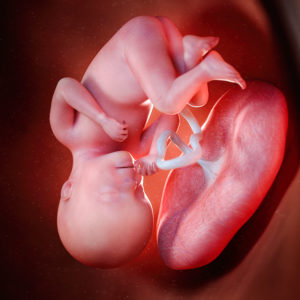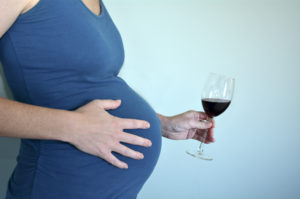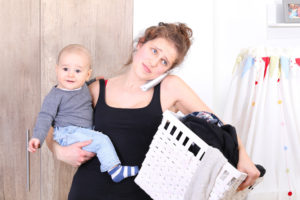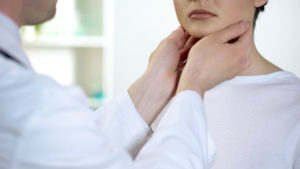 According to the American Pregnancy Association, approximately 1 in 2,500 pregnancies experience placenta accreta, increta or percreta. Placenta accrete is a potentially dangerous pregnancy complication in which the placenta grows too deeply into the uterine wall. In the highest risk cases, the placenta grows into the uterine muscles, a condition that is known as placenta increta, or through the uterine wall, known as placenta percreta. Instead of detaching from the uterine wall after childbirth as is typical, in cases of placenta accreta, part or all of the placenta remains attached, which can cause severe blood loss.
According to the American Pregnancy Association, approximately 1 in 2,500 pregnancies experience placenta accreta, increta or percreta. Placenta accrete is a potentially dangerous pregnancy complication in which the placenta grows too deeply into the uterine wall. In the highest risk cases, the placenta grows into the uterine muscles, a condition that is known as placenta increta, or through the uterine wall, known as placenta percreta. Instead of detaching from the uterine wall after childbirth as is typical, in cases of placenta accreta, part or all of the placenta remains attached, which can cause severe blood loss.
The most significant risk factor for placenta accreta is one or more previous cesarean sections (C-sections). According to research by the National Accreta Foundation, 87.6 percent of women have had a repeat C-section, increasing their risk for developing this dangerous complication. If you have had a past C-section and are trying for baby number two (three, four, or more), familiarize yourself with the causes and risks of placenta accreta.
Placenta Accreta Risk Factors
Women with the following factors may be at a higher risk of developing placenta accreta:
- A prior uterine surgery or multiple surgeries that have left scar tissue.
- Multiple past pregnancies, especially if delivered via C-section.
- A placenta that develops lower in the uterus or that wholly or partially covers the cervix (known as placenta previa).
- Age 35 or older.
Symptoms of Placenta Accreta
Before birth, placenta accreta often causes no symptoms, other than in some cases, vaginal bleeding during the third trimester. As a result, the diagnosis, and its potential risks, often come as a surprise to inflicted women. During childbirth, however, placenta accreta may cause:
- Heavy vaginal hemorrhaging post-delivery that could be life-threatening that is caused by disseminated intravascular coagulopathy, a condition that affects the blood’s ability to clot.
- Adult respiratory distress syndrome (lung failure).
- Kidney failure that requires a blood transfusion.
- Premature birth.
Diagnosis and Treatment Options for Placenta Accreta
A doctor can sometimes detect and diagnose placenta accreta during an ultrasound. If diagnosed during your pregnancy, your OBGYN may prescribe a cesarean section delivery followed by a surgical procedure to remove the entire uterus (a hysterectomy).
For More Information
For more information on placenta accreta, or to better understand your risk factors and delivery options, talk to your OBGYN. He or she can help you understand your options to put you and your baby in the best position for a healthy birth.
More
 Thanks to modern day advancements in medicine and technology, safe deliveries of healthy babies are more controllable and possible than ever before. Before the advent of sonograms, the ability to prepare and respond to a baby set to be born breech—in an inverted position with the feet or buttocks set to travel through the birth canal before the head—was often more challenging to diagnose. While identifying breech birth positions in advance of labor is now easier and more accurate, the number of babies who find themselves positioned for a breech birth is still high.
Thanks to modern day advancements in medicine and technology, safe deliveries of healthy babies are more controllable and possible than ever before. Before the advent of sonograms, the ability to prepare and respond to a baby set to be born breech—in an inverted position with the feet or buttocks set to travel through the birth canal before the head—was often more challenging to diagnose. While identifying breech birth positions in advance of labor is now easier and more accurate, the number of babies who find themselves positioned for a breech birth is still high.
What is Breech Delivery?
In an ideal vaginal birth, the baby is positioned with his head in the pelvis and leaves the birth canal head-first. With the head being the widest part of the body, the shoulders and body can more easily pass through the birth canal when they follow the head. In a breech delivery scenario, the baby is situated in an inverse position, with the challenge of needing to leave the birth canal feet or buttocks first. There are three types of breech positions:
- Complete breech: Buttocks point down with legs folded at the knees and feet near the buttocks
- Frank breech: Buttocks aimed at the birth canal with legs sticking straight up in front of the baby’s body and the feet near the head.
- Footling breech: One or both feet are pointed down and in position to deliver before the rest of the body
How Many Women Still Deliver Breech?
Approximately one out of every 25 full-term babies are breech positioned.
What are the Risks of a Breech Delivery
A study conducted in The Netherlands found that “breech babies born vaginally had a 33 percent higher risk of injury or death compared to those born by C-section.”1 When babies attempt to leave the birth canal feet first, their head can get stuck before exiting, and they are at risk of other health complications such as broken bones and bleeding. Breech babies born vaginally also tend to have lower Apgar scores compared to breech babies born via C-section. Apgar scores are an indication of a baby’s general health at the time of birth and are used to identify if immediate emergency care is required. Apgar stands for appearance (skin color), pulse, grimace response (reflexes), activity (muscle tone), and respiration.2
However, the study may have been flawed. When the “researchers re-assessed babies from high-income countries two years later, the risks from vaginal breech births seemed to disappear completely: 3.1% of the toddlers born by planned C-section died or had severe neurological disorders, while 2.8% of those born vaginally did.”3 Overall their study wasn’t large enough to catch anything but very large increases in morbidity. In other words, there might have been a smaller effect, but this study wasn’t big enough to see it.
Then, in 2006, the Premoda study, an observational study of more than 8,000 women in France and Belgium, found no difference in the rates of serious illness or deaths between breech babies delivered by trial of labor and those delivered by C-section. This is often used as a rebuttal against the TBT, as it seems to show that well-selected cases done in high-income countries are safe.
Can Breech Babies be Born Vaginally Or Must They be Birthed Via C-Section?
While vaginal breech births are possible, the risks are higher than when born via C-section. Still, as recently as 2007, 40 percent of women faced with a breech birth and given the option for a C-section still chose to have a vaginal birth—despite the risks.
What to Do if Your Baby is in a Breech Position
Before or during labor, if your OBGYN determines that your baby is in a breech position, he or she may recommend a C-section. If your birth plan involves a vaginal birth, and you strongly want to pursue that approach despite the risks, you and your doctor will need to collaborate on the best course of action to produce the safest and healthiest possible outcome for both you and your baby.
1. Reuters ↩
2. BrennerChildrens.org ↩
3. HealthyDebate.ca ↩
More
 Loneliness and isolation occurs when an individual lacks social connection. Whether the lack of connection is unintentional or desired, it can lead to mental health disorders.
Loneliness and isolation occurs when an individual lacks social connection. Whether the lack of connection is unintentional or desired, it can lead to mental health disorders.
Loneliness can start in childhood; children that who are not talked to may develop depression and learning disabilities. As adolescents hit their teenage years issues with loneliness can grow due to stress from peer pressure, mental and physical development, and school expectations. In teens, loneliness is typically associated with emotional changes such as feeling isolated, feeling worthless, low self-esteem, and trouble concentrating. If left untreated, these issues can develop into depression or anxiety disorders.
The issues with loneliness continue with age, as around 25% of adults report they are lonely and have no one to confide in. Additionally, loneliness in adults can led to a higher risk of depression, addiction, suicide, weight gain, hypertension, heart attack, stroke, and other illness.
Loneliness is also a concern for many aging seniors (55+). According to an AARP initiative, contributing factors that lead to isolation include poor mental and physical health, loss of spouses and friends, and isolated living conditions. Many seniors have a lack of mobility or transportation which limits their social interaction with others.
While the interactions online appear to be combating loneliness, it’s not always the case. Online interactions offer a contrived social setting, which is not a replacement for actual in person socialization.
The first step to combating loneliness is to work on interpersonal skills. Many people shy away from social interactions or develop social anxiety because they lack communication skills. Breaking isolation means breaking out of a comfort zone. While therapy and counseling are a good place to start, smaller initiatives can help pave the way to become involved in social settings. Ask a co-worker out for coffee, ask an acquaintance to take a walk, or join a community or online group.
Once you get more comfortable talking to strangers, look for a fitness activity that you enjoy. Exercising is decreases stress, creates more energy, and boosts your mood, while also serving as a good way to interact with people.
Another way to beat loneliness is to find a cause to volunteer for or a local group that needs support. Not only will you get out and interact with people, which could lead to making new friends, but you will be doing something good for society.
Source:
https://www.mayoclinic.org/diseases-conditions/teen-depression/symptoms-causes/syc-20350985
More
 Taking antidepressants during pregnancy remains a concern to many women. This decision will vary from person to person, where the risks and benefits should be carefully assessed.
Taking antidepressants during pregnancy remains a concern to many women. This decision will vary from person to person, where the risks and benefits should be carefully assessed.
Untreated depression may result in less than ideal life choices during pregnancy, including diet, rest, and exercise. Additionally, the Mayo Clinic suggests major depression during a pregnancy has been associated with an increased risk of low birth weight, premature birth, decreased fetal growth, and other problems.
While the risks of untreated depression are real, there are also risks with taking antidepressants during pregnancy. Ongoing research points to no established links between antidepressants and birth defects, but it’s still possible for the medication to affect the baby. Doctors will typically look to decrease the baby’s exposure to the medication through a low single daily dosage. It’s particularly important to lower the baby’s exposure during the first trimester.
The following list examines commonly used medications:
- SSRIs such as Zoloft, Celexa, and Prozac. Research does not show connections with birth defects, but risks can include low birth weight, premature birth, and a small increase of a fatal heart defect.
- SNRIs such as Cymbalta and Effexor XR. Risks of taking during end of pregnancy has been linked to postpartum hemorrhage.
- Bupropion such as Wellbutrin. While often not a first choice for use during pregnancy, it may be an option for women who don’t respond to the other medications. Possible risks include heart defects.
- Benzodiazepines such as alprazolam and clonazepam. These types of medications are tranquilizers and should be avoided in high doses during pregnancy. Risks are associated with sedation and respiratory distress in newborns. While small infrequent doses are less risky, doctors may instead recommend an intermediate-acting option such as lorazepam.
Any women considering the risks of antidepressants should consult their physician and/or a psychiatrist. More holistic options can be employed for women with more mild depression. These options include acupuncture, prenatal yoga, and psychotherapy. The last thing to remember that exercising and eating healthy are the first and most important step to better mental health. An ideal diet will focus on lean proteins, fruits, veggies, and whole grains. Omitting or limiting processed (pre-packaged or fast-foods) is also imperative. Women should choose whole foods whenever possible.
Sources:
https://www.mayoclinic.org/healthy-lifestyle/pregnancy-week-by-week/in-depth/antidepressants/art-20046420
https://www.hopkinsmedicine.org/health/wellness-and-prevention/antidepressants-and-pregnancy-tips-from-an-expert
More
 Over the past few decades, the average age of a first-time mother has shifted from 24 to 26. Moreover, many women will wait until their mid-30s or even 40s to have their first child. Of course, this number varies greatly based on a number of factors (married status, socioeconomic status, education level, geographical location, etc.). However, with a college education necessary to earning middle-class wages, many women are choosing to finish college and start a career before having children.
Over the past few decades, the average age of a first-time mother has shifted from 24 to 26. Moreover, many women will wait until their mid-30s or even 40s to have their first child. Of course, this number varies greatly based on a number of factors (married status, socioeconomic status, education level, geographical location, etc.). However, with a college education necessary to earning middle-class wages, many women are choosing to finish college and start a career before having children.
Generally, pregnancies up to 35 years of age are less risky. Once women hit 35, doctors begin to refer to this age range as advanced maternal age, as more risks can develop. However, many women of over 35 years of age can also achieve a healthy pregnancy. While deciding when to start a family is a uniquely personal decision, here are a list of aspects to consider.
Pros and Cons Regarding Advanced Maternal Age
Cons of Advanced Maternal Age
- Older eggs and chromosomal abnormalities: As the body ages with time, so does a women’s limited supply of eggs. As the eggs get older, chromosomes are more likely to become displaces, which can lead to genetic disorders. Additionally, down syndrome is more likely to occur in babies when mothers are over 35.
- Issues conceiving: With a limited number of eggs, getting pregnant may become more difficult past 35. Woman not ready for children before 35 may consider freezing eggs.
Pros of Advanced Maternal Age
- Cognitive development: Recent studies have shown that children with supportive care givers, do better cognitively. Thus, women who wait to find a suitable partner and/or stable career often have the means to foster a stable home life, which can lead to better cognitive development of the child.
- Establishing healthy habits: The best way to prepare for an advanced maternal age pregnancy is to start eating healthy, exercising, and limiting excessive habits (drinking, smoking, etc.). Many women achieve healthy pregnancies at 35 or 40 if they take care of their bodies.
The main takeaway is to plan accordingly. If having kids prior to 35 is within your means and interest, then there’s no reason to put it off. However, if you are approaching 35 or 40, there’s still time to figure it out. The best thing to do is begin living a healthy lifestyle as soon as possible. This starts with basic maintenance like eating five servings of fruits and veggies each day, limiting processed and high-fat foods, drinking plenty of water, and exercising 150 minutes per week. And remember to see your OBGYN before you plan on getting pregnant. He/she can help you come up with a healthy plan of action for pregnancy.
More
 It’s been a long winter in Western New York… And spring weather means that the kids can finally go outside to play!
It’s been a long winter in Western New York… And spring weather means that the kids can finally go outside to play!
While most kids would prefer to be glued to their screens (phones, tablets, computers, TVs, etc.) all-day long, it’s not healthy for their development or physical fitness. The American Academy of Pediatrics recommends that kids limit screen time to one to two hours per day; although, many kids spend four or more hours looking at a screen each day.
The following list provides some guidance for parents to help encourage a healthier lifestyle for children.
- Find an organized team sport. Sports are an easy way to make your children more active. This includes school teams, little league, and intramurals.
- Find an individual sport/activity. Swimming, cheer, horseback riding, karate, gymnastics, yoga, etc. all represent great ways to get your kids moving.
- Make exercise a part of your family routine. Look for ways to incorporate activities you can do together. Family gym memberships (especially a YMCA-type facility) offer opportunities for parents and children to exercise together. Look for family yoga, swimming, or rock-climbing classes. If you aren’t a gym person, then look for ways to get outside. Weather permitting, set aside a few days per week for family bicycle rides, walks around the neighborhood, nature walks, hikes, or even kicking a ball around in the yard!
Additionally, look for opportunities to spend time at a local playground or get your kids together with friends for shooting hoops or a good ‘ol game of tag. Even a family dog walk is a great way to get some exercise.
Sources:
https://www.webmd.com/parenting/features/kid-fitness-when-your-child-wont-exercise#2
https://kidshealth.org/en/parents/active-kids.html
More
 With the endless supply of information available online, it’s not always easy to negotiate healthy eating habits. With the news and social media buzzing about new trends like keto and paleo, it can be hard to keep track. Here’s a quick summary of the current trendy diets, with a suggested plan of how to eat healthy food.
With the endless supply of information available online, it’s not always easy to negotiate healthy eating habits. With the news and social media buzzing about new trends like keto and paleo, it can be hard to keep track. Here’s a quick summary of the current trendy diets, with a suggested plan of how to eat healthy food.
Diet Trends
- The Keto Diet: The keto diet revolves around eating very few carbohydrates and filling up on fatty foods. Essentially, it keeps your body in a state of ketosis; in this state, your body breaks down both dietary and stored body fats. While this diet is certainly not heart healthy, many people use it to jump start the weight loss. However, this updated version of Adkins is not sustainable for the long run because eating diets high in fat is not good for your organs.
- The Paleo Diet: The paleo diet calls for foods that would have been eating by our ancestors in the Paleolithic era (roughly 10,000 to 2.5 million years ago). During this state of evolution, humans were hunters and gathers. Paleo diets include meat, fish, fruits, veggies, nuts and seeds, while avoiding proceeded foods, dairy, legumes, and grains. Similar to the keto diet, paleo diets also limit carbohydrates, however, paleo doesn’t allow dairy or cheese. This diet would likely be hard to continue over a long period due to the extremely limited amount of foods available. Additionally, there is no long-term evidence yet to know if this is safe.
- The Mediterranean Diet: This diet based on the Mediterranean region along the water in Italy, Greece, and France, relying on eating large amounts of lean meat, fruits, and veggies. In fact, fruits and vegetables should make up the largest section of the food pyramid. Olive oil is a key ingredient for cooking and salad dressings. Whole grains, nuts, beans, and legumes are eaten in moderation. Lean meats and fish are favored, as opposed to red meat or processed meats.
Of the three diets discussed, the Mediterranean is the healthiest for long-term use. However, when all is said and done, the best way to lose weight is the old-fashioned way – eat less and move more. Fill up on fruits, veggies, lean protein, and drink plenty of water. And, when possible, avoid or limit processed foods, cheese, sweets, alcohol and other high fat foods.
As for exercise, adults should target 150 minutes per week, breaking down to 30 minutes five days per week. Moderate intensity —such as brisk walking, biking, aerobics, swimming, elliptical use, jogging, and even faster paced yoga— are all good options. The trick is finding what you enjoy and mixing it up to avoid boredom. Consider taking brisk walks at your lunch hour a few days a week, while saving longer work outs for weekends when you have more time.
Sources:
https://health.usnews.com/best-diet/mediterranean-diet/dos-and-donts
https://www.mayoclinic.org/healthy-lifestyle/nutrition-and-healthy-eating/in-depth/paleo-diet/art-20111182
https://health.usnews.com/best-diet/keto-diet
More
 When you’re pregnant, everything you do and every choice you make impacts your unborn baby. That means that when you consume alcohol, your baby does too. Fetal alcohol syndrome can have a severe impact on your newborn and his or her ability to develop into a healthy infant. In the worst case scenario, the consequences could be fatal. Whether you drink only on occasion, daily, or know that you have a substance abuse addiction, all women who are pregnant or could become pregnant need to understand the causes and risks of this dangerous condition.
When you’re pregnant, everything you do and every choice you make impacts your unborn baby. That means that when you consume alcohol, your baby does too. Fetal alcohol syndrome can have a severe impact on your newborn and his or her ability to develop into a healthy infant. In the worst case scenario, the consequences could be fatal. Whether you drink only on occasion, daily, or know that you have a substance abuse addiction, all women who are pregnant or could become pregnant need to understand the causes and risks of this dangerous condition.
What is Fetal Alcohol Syndrome?
Fetal alcohol syndrome is a condition that impacts newborns that are exposed to alcohol during the mother’s pregnancy.
Causes of Fetal Alcohol Syndrome
Consuming alcohol while pregnant is the cause of fetal alcohol syndrome. When pregnant, alcohol enters the bloodstream and travels to the developing fetus via the placenta. For a fetus with a slower ability to metabolize alcohol, the exposure results in higher blood alcohol concentrations compared to an adult that can negatively impact the fetus’ delivery of oxygen and nutrition. It can also affect the healthy development of organs and tissues. While there is no defined quantity of alcohol that is considered the tipping point at which a baby will suffer the negative consequences of fetal alcohol syndrome, the more a pregnant mother drinks while pregnant, the higher the risk to her baby.
What are the Symptoms of Fetal Alcohol Syndrome?
Fetal alcohol syndrome can cause physical, emotional, and developmental issues and brain damage to a newborn. Issues may include:
- Distinctive facial features such as a small head, small eyes, a short, upturned nose, a thin upper lip, and a smooth area between the nose and upper lip.
- Deformities of the limbs, joints, and fingers.
- Slowed physical development before and after birth.
- An undersized brain.
- Visual or auditory impairments.
- Heart defects.
- Problems with kidneys.
- Poor social skills.
- Difficulty getting along with others.
- Trouble adapting to change.
- Difficulties staying on task.
- Problems with behavior and impulse control.
- Difficulty with time management.
- Cognitive and central nervous system issues such as:
- Poor balance and coordination.
- Poor memory.
- Intellectual disabilities such as learning disorders or delayed development.
- Poor attention span.
- Difficulty processing information, problem solving, and reasoning and judgment.
- Hyperactivity.
- Mood swings.
The severity of such physical and behavioral issues may vary significantly among children diagnosed with fetal alcohol syndrome, but none of these defects are reversible as the child ages.
There is no amount of alcohol that is considered safe to consume while pregnant. If you are pregnant or hoping to become pregnant and are struggling to eliminate alcohol consumption from your daily life, talk to your OBGYN. He or she can provide you with the support and resources needed to make positive lifestyle changes that will protect your baby and give him or her the best chance for a healthy life.
More
 It’s 3 a.m. You haven’t slept more than three consecutive hours in weeks. You have a pile of laundry that’s long overdue for washing, your spouse is out of town, and now your baby has a fever.
It’s 3 a.m. You haven’t slept more than three consecutive hours in weeks. You have a pile of laundry that’s long overdue for washing, your spouse is out of town, and now your baby has a fever.
Sometimes, as a parent, it feels like every point of stress converges on you at once, but that doesn’t mean you have to navigate your parental challenges alone. It’s okay to ask for help. In fact, the women who are most successful at balancing family, work, and self, will tell you that the key to their success is a loving and accommodating support network of friends and family—not some unrelenting drive to do it all on their own. If you feel like you’re standing with your baby on the edge of a meltdown with no help in sight, then it’s time to ask for help. Here’s how to say the words out loud.
- Leverage Your Full Support Network. Resist the assumption that only your parents or best friend will be willing to help. Anyone who has ever had a baby—and even your single friends—will all understand that for the baby’s first few months, you’re on 24/7/365 baby nurturing and caregiving. Ask your family, your spouse’s family, your friends, and even neighbors to help. By leveraging an expanded network, you can avoid feeling like you are a burden to any single family member or friend.
- Be Specific in Your Requests. When asking someone for help, be specific about what you need. The people who care about you will want to make life easier for you, but they may not know how. Without specifying where you need extra hands, you may end up with more help than you need in one area (think, too many extra prepared meals to enjoy), or days when visits from friends and family turn into social calls only. Ask your sister to come over and help you with the laundry, or ask your best friend to help with your grocery shopping. By being specific in your requests, you can ensure your essential chores are being completed while you bond with your baby.
- Share Responsibilities with Your Partner. While your partner can’t help with breastfeeding, he or she can help with changing diapers, swaddling, bathing, and rocking, in addition to household chores. Whether your partner is home on paternity leave, or it’s outside of work hours, communicate and collaborate to share as much of the baby caregiving responsibilities as you can. If you need your partner to step up and help out more any time, don’t feel like you can’t ask.
- Say Yes When Someone Offers to Help. One mistake that too many new mothers make is not accepting help when someone offers out of a feeling that they have to be as capable and self-sufficient as they always have been before being a mom. When a friend or family member says, “Let me know if there is anything I can do to help,” use that as an opportunity to ask for what you need. It’s much easier for those who struggle with asking for help to say yes to an offer rather than asking out of the blue.
The first few months of your baby’s life are critical for his or her healthy development, and vital for your healing and bonding time. Don’t let the stress of dusting, mopping, mowing the lawn, and other household chores divert your focus from where it needs to be. By allowing those who care for you to help you, you’ll be a better, more attentive mom, and your loved ones will enjoy knowing that they were there for you when you needed help—just like all the times you’ve been there for them.
More
 Your thyroid is a small gland that is critical for regulating a variety of bodily functions. Several conditions can affect the thyroid and cause a variety of complex symptoms. If you believe you may be experiencing any of the thyroid problems described below, make an appointment to speak with your doctor.
Your thyroid is a small gland that is critical for regulating a variety of bodily functions. Several conditions can affect the thyroid and cause a variety of complex symptoms. If you believe you may be experiencing any of the thyroid problems described below, make an appointment to speak with your doctor.
Hypothyroidism
A condition marked by an underactive thyroid that affects approximately 4.6 percent of people 12 years old and older. When your thyroid underproduces the hormones that control your metabolism, you may experience:
- Weight gain
- Fatigue
- Depression
- Memory problems
- Slowed heartbeat
- Slowed reflexes
- Dry skin
- Increased sensitivity to cold
- Constipation
- Weakness
- Coma
Hyperthyroidism
A condition in which your thyroid overproduces hormones, resulting in such symptoms as:
- Weight loss
- Anxiety or nervousness
- Insomnia
- Rapid heartbeat
- Restlessness
- Irritability
- Increased sweating
- Shaking
- Thin skin
- Brittle hair and nails
- Muscle weakness
Hyperthyroidism affects about one percent of women and is less common in men.
Goiter
Swelling of the thyroid. Goiter may be the result of hypothyroidism or hyperthyroidism. Goiter may appear on one or both sides of the thyroid gland.
Thyroid Nodules
Also called toxic nodular goiter or multinodular goiter, the condition is marked by small growths that develop in the thyroid. The nodules are typically round and move with the gland when you swallow or roll underneath your fingertips when examining the area. When benign, they rarely cause associated complications.
Graves’ Disease
An autoimmune disorder in which the body’s immune system mistakenly attacks the thyroid gland, causing an overproduction of hormones. Graves’ Disease can cause swelling of the tissue around the eyes, hyperthyroidism, and sometimes skin issues. One notable symptom is the appearance of bulging eyes. It affects approximately 70 percent of people with an overactive thyroid. Graves’ disease is hereditary and is most common in women ages 20 to 30. Other risk factors include smoking, stress, and pregnancy.
Hashimoto’s Thyroiditis
Also known as chronic lymphocytic thyroiditis, it is an autoimmune disorder in which the immune system attacks and slowly destroys the thyroid gland and its ability to produce hormones. As a result, the thyroid becomes inflamed. Hashimoto’s thyroiditis can cause hypothyroidism and goiter and affects approximately 14 million Americans. Mild cases of Hashimoto’s thyroiditis may cause no noticeable symptoms. In more severe cases, symptoms may include mild weight gain, fatigue, depression, constipation, dry skin or hair, pale skin, puffy face, and irregular menstruation in women.
Thyroid Cancer
The development of cancerous nodules in the thyroid. Often thyroid cancer is treatable and curable.
If you are experiencing any of the symptoms associated with these common thyroid problems, talk to your doctor. He or she can perform tests to determine if your thyroid is to blame for your symptoms and can prescribe treatment.
More
 According to the American Pregnancy Association, approximately 1 in 2,500 pregnancies experience placenta accreta, increta or percreta. Placenta accrete is a potentially dangerous pregnancy complication in which the placenta grows too deeply into the uterine wall. In the highest risk cases, the placenta grows into the uterine muscles, a condition that is known as placenta increta, or through the uterine wall, known as placenta percreta. Instead of detaching from the uterine wall after childbirth as is typical, in cases of placenta accreta, part or all of the placenta remains attached, which can cause severe blood loss.
According to the American Pregnancy Association, approximately 1 in 2,500 pregnancies experience placenta accreta, increta or percreta. Placenta accrete is a potentially dangerous pregnancy complication in which the placenta grows too deeply into the uterine wall. In the highest risk cases, the placenta grows into the uterine muscles, a condition that is known as placenta increta, or through the uterine wall, known as placenta percreta. Instead of detaching from the uterine wall after childbirth as is typical, in cases of placenta accreta, part or all of the placenta remains attached, which can cause severe blood loss.








